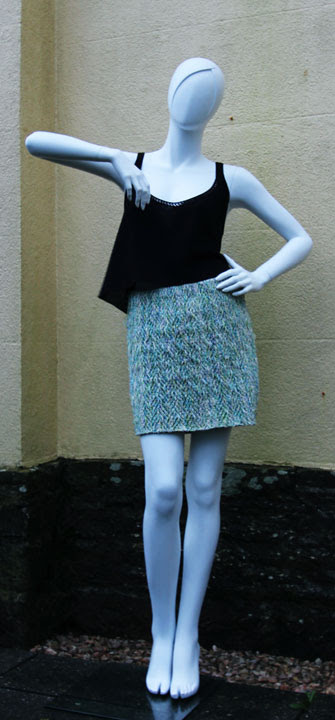Love your lace Here’s a tip about re-programming your punchcard machine if you’ve made a mistake when knitting a lace pattern. It’s always best to undo the whole block repeat of lace just knitted. This may mean putting several stitches that are on one needle back to their original place. Turn the punchcard back to where the last black curved arrow is on the card. It’s at this point you’d have worked, for example, ‘K 2 rows’ or similar. Look at the arrows on the left hand side of the card. By the black arrow is the red arrow, pointing to the right. Don’t lock the card, but carry on ‘lacing’ and you will be on the right row. The only time you do lock the card, when re-programming in lace, would be if the arrow was pointing to the right and the lace carriage was on the left. You’d next work one pass with the lace carriage and then release the card.
Sausage roll Have you any idea what’s a ‘knitted sausage’? For the life of me, I’ve never heard of it, but I’ve been told it really is something well-seasoned knitters know about and use. I’m not in the first flush of youth, but obviously need to keep going a bit longer before I’ve got enough seasoning! Can you help, please?
A ‘sausage’ is what some knitters used to call a cast-on strip and newbies will have no idea what we’re talking about. Instead of using waste yarn that we usually throw away, the ‘sausage’ or ‘cast-on strip’ not only saves yarn, but also gives even weighting to the work. It can be any width you like and there are many versions, but this one used to be popular. Most knitters made one long enough to use over about 100 stitches and a second that’s long enough to use when all needles are in work across the full width of the bed.
To knit it Over about 20 needles at the extreme left of the needlebed, cast on and make a bias strip in a brightly coloured 4-ply yarn. The colour isn’t really important but as it’s going to have a lot of handling, use a good quality yarn. Make the bias strip the length you wish and cast off. Steam press the strip well. Buy some curtain weighting in medium thickness and sew this weighting onto the edge where you did the decreasing. We use this edge because the side with increasing will have little holes all the way along it.
To use it Bring up required number of needles. Using a treble transfer tool, put the ends of the prongs through the little holes along the top edge onto the needles. The strip now hangs down very evenly all along. Using a nylon cord or similar, about Tension 6, knit one row. Continue now as you wish, either casting on again or going straight into knitting. On completion, pull one end of the cord gently, then go to the other end and pull it right out. The strip drops away, ready for use next time.
Warm as toast Here’s an easy hot water bottle cover to knit. Choose a Fair Isle pattern to make it cosier and it gives us the chance to use up scraps of waste yarn. Any yarn can be used but 4-ply is ideal. You can vary the number of rows and stitches but basically, cast on around 75 sts and K 10 rows plain. Change to Fair Isle for about 115 rows. K 5 rows plain. Cast off centre 12 sts with some scrap yarn and then cast them on again. This makes a hole for the bottle’s tail. Now knit the other half in reverse. For the tabs, measure 2½ inches in from each end, pick up 12 stitches and work 30 rows. Sew up the cover and, for extra strength, work a row of double crochet around the top edge and tabs. Sew snap fasteners on the tabs and front to finish it off.
Heat treatment Don’t we all have to unpick a piece of knitting? Wind the unravelled kinky yarn round a large heatproof jar and not too tight, just comfortable. It’s best to wind it as you go, so you don’t end up with a heap of kinks. Fill the jar with nearly boiling water and leave it to cool. By the time the water is cool, the yarn will be straight. If you don’t have a jar, someone I know uses a hot water bottle but I’ve never tried it. If you did this, I guess you might have to fill the bottle first and take care wrapping it round the hottie. You can then use a wool winder to wind the yarn back into a neat ball, ready to use again. I’ve done it for years and it may well have been a ‘Joan Lafferty special’! Keep knitting our way,
Waste not, want not Inspired by some of the articles I’ve read recently, I tried my hand at felting. Once I’d got the hang of it, I got completely carried away and then ran out of ideas what to do with all the felt. Not for long! I traced round an inner sole that I have in my trainers and now I’ve lovely warm, comfortable insoles. My husband’s a keen gardener, so he threw the cut-off bits on his compost heap.


